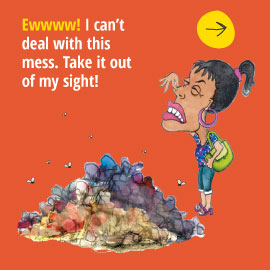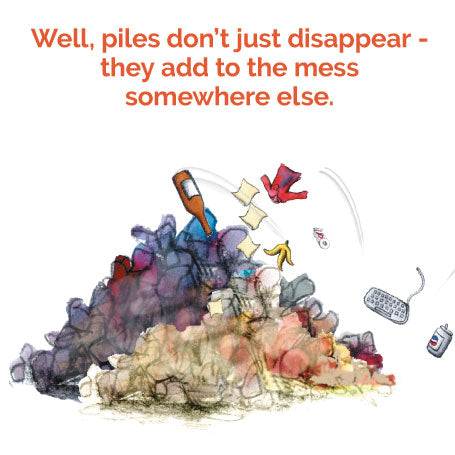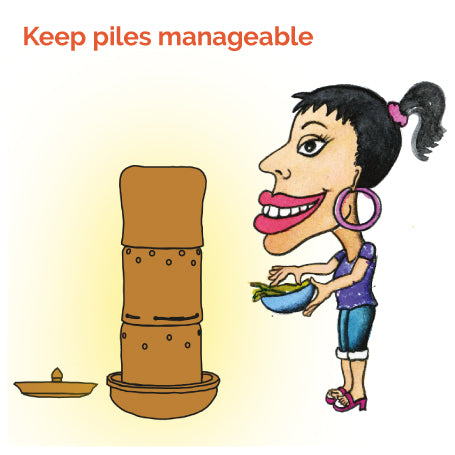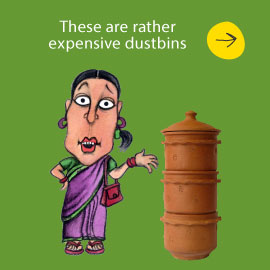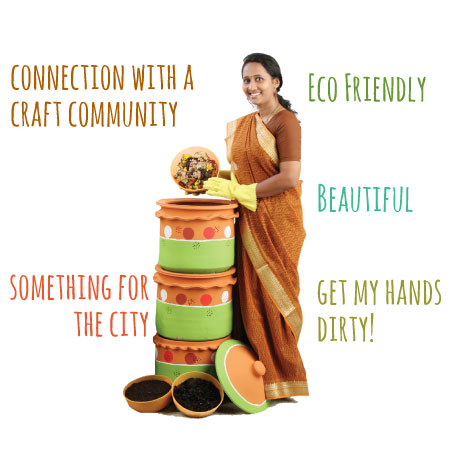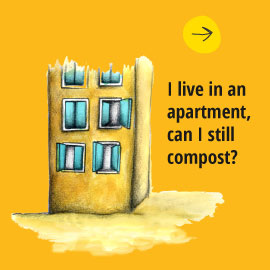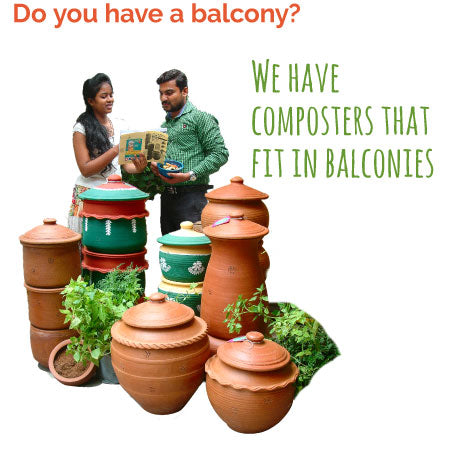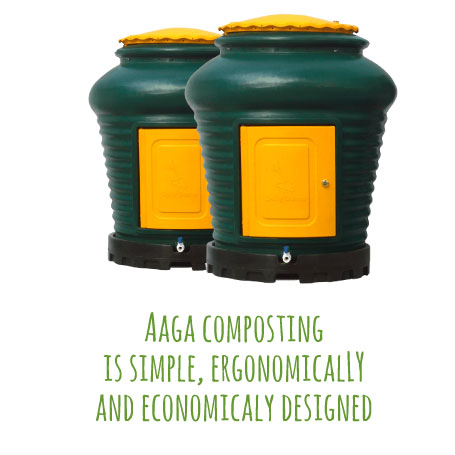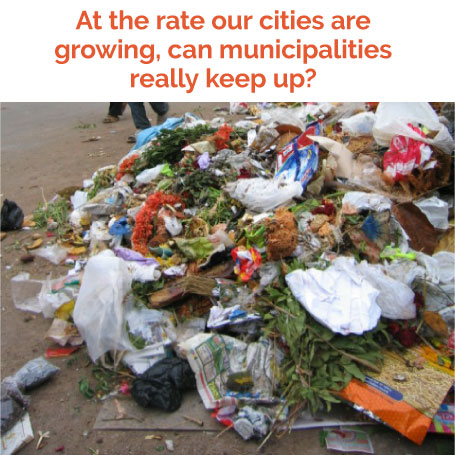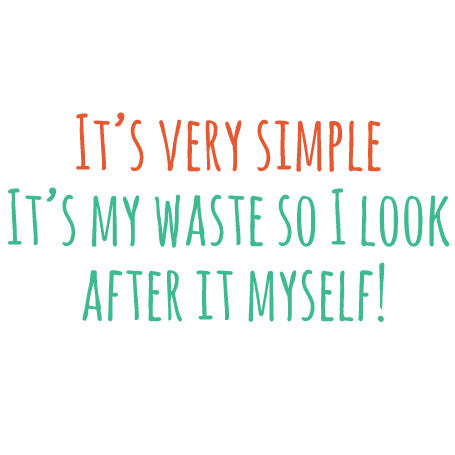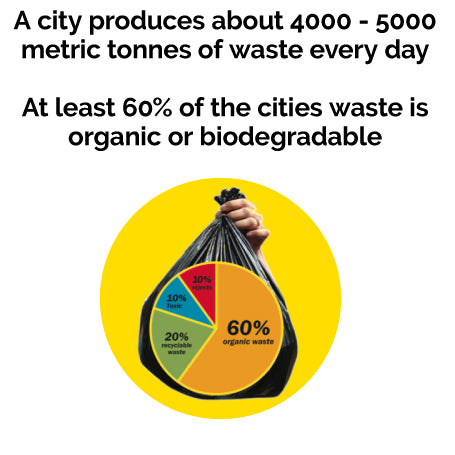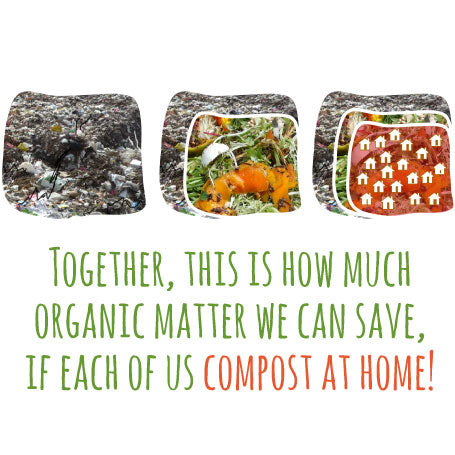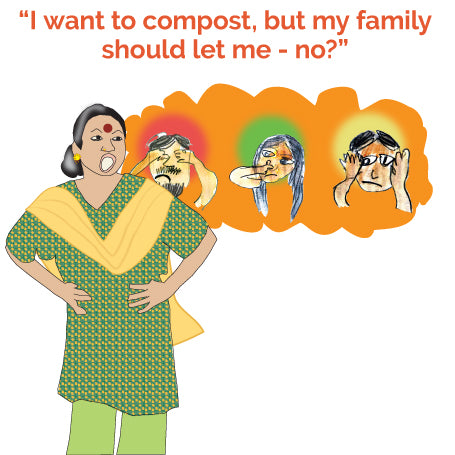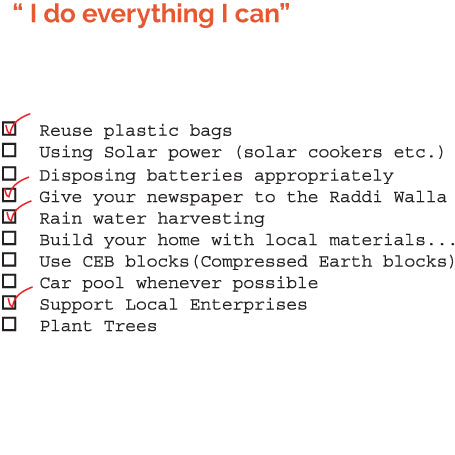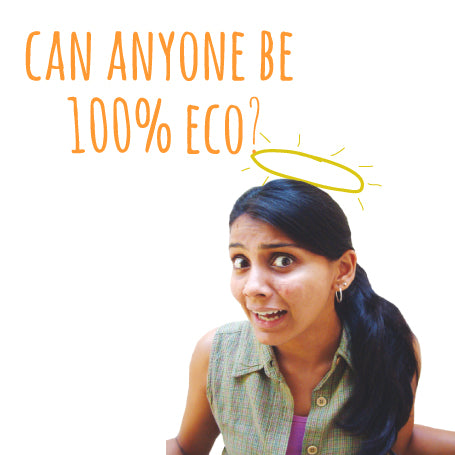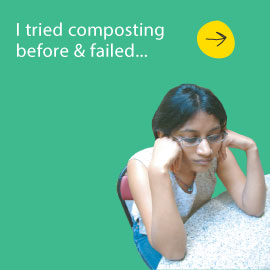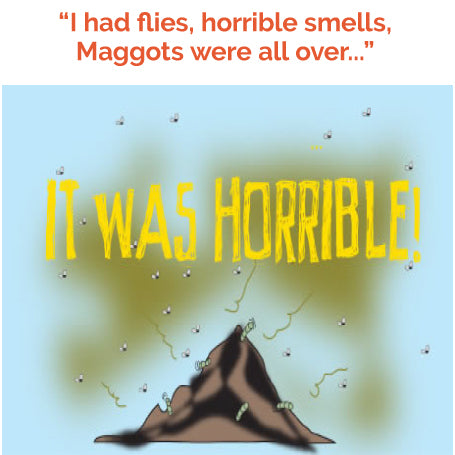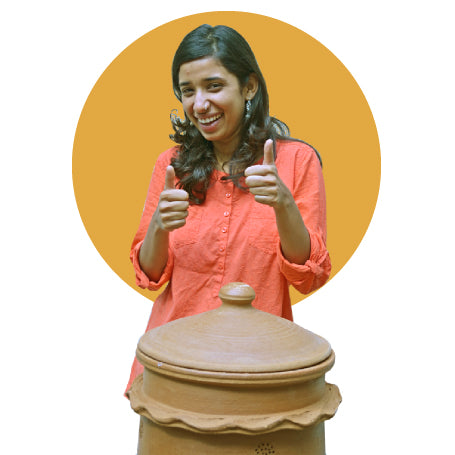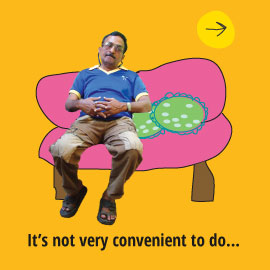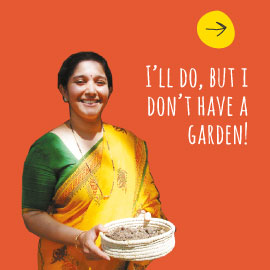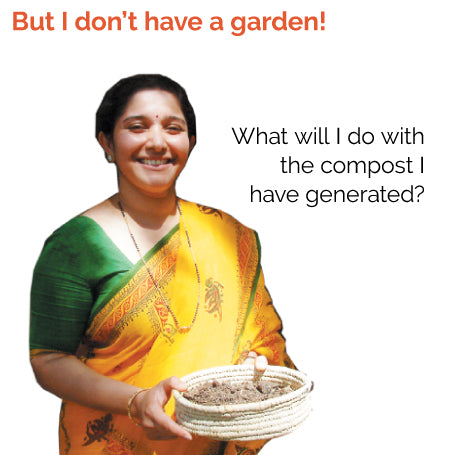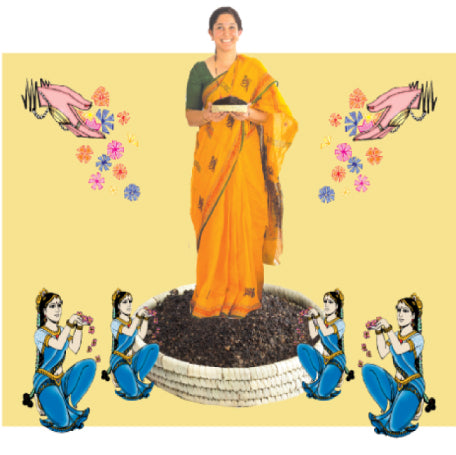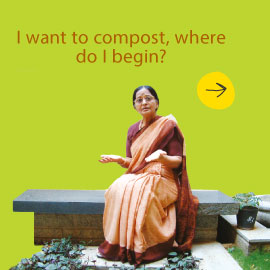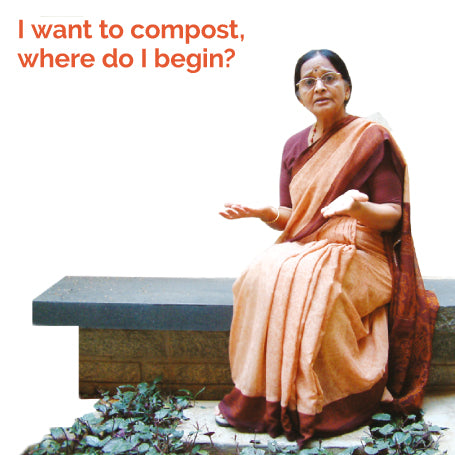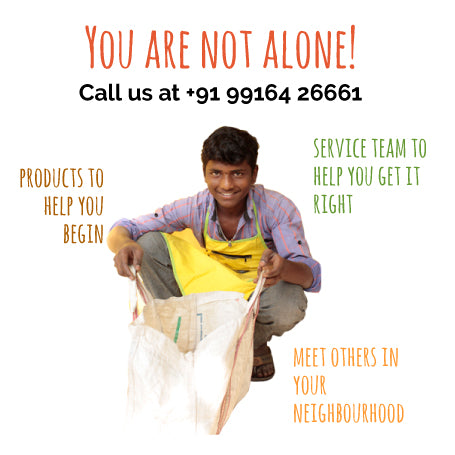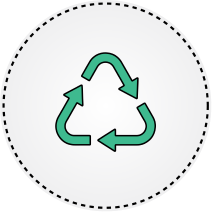Convince Me
Over the years we have heard lots of reasons why people don’t want to manage their waste.
Here are the top 12 reasons and our responses to them.
You can use these to convince your family, friends, builder or community.
Do start composting!
FAQs?
Check out our Topic based FAQ’s to answer all your queries!
FAQs about Composting Basics
Answer
Composting is the decomposition of plant remains and other once-living materials to make an earthy, dark, crumbly substance that enriches soil.
It is a process of recycling your kitchen and garden wastes, and is a critical step in reducing the volume of garbage needlessly sent to landfills for disposal.
Composting is not a new idea. In the natural world, composting is what happens as leaves pile up on the forest floor and begin to decay. Eventually, nutrients from the rotting leaves are reclaimed by living roots. This completes nature’s recycling process.
Answer
It is as old as man. Some cultures practiced it more than others. In recent times its advantages have made it an important part of agricultural practice world wide. It is gaining recognition as a safe method to regenerate the earth.
Answer
Yes, because compost is nature's way of recycling nutrients.
Answer
In broad terms, there are two major kinds of food that composting microbes need: 'Browns' are dry and dead plant materials such as straw, dry brown weeds, leaves and twigs. These materials are primarily composed of chemicals that are long chains of sugar molecules linked together. Browns are a source of carbon and energy for compost microbes. 'Greens' are fresh plant materials such as green leaves and garden clippings, kitchen, fruit and vegetable scraps, coffee grounds, tea bags, etc. Compared to browns, greens contain more nitrogen which is a critical element in amino acids and proteins. So greens can be thought of as a protein source for the billions of multiplying microbes. Browns, tend to be bulky and promote good aeration. Greens, on the other hand, are typically high in moisture, and balance out the dry nature of the browns. A good mix of browns and greens forms the best nutritional balance for microbes. This mix also helps maintain aeration and moisture levels in the pile. The above explanation is a simplified way of understanding compost. For a more detailed scientific explanation see site - according to us, it explains compost very well.
Answer
Yes, compost happens faster in warm weather. Our Indian weather is ideal for composting in most parts of the country. We just have to make sure that the moisture is right in places where it gets too hot and dry
Answer
Composting helps prevent global warming by reducing emissions of methane, a powerful greenhouse gas which gets produced when organic waste decomposes when buried in landfill sites. Read a paper here that shows how composting reduces green house gases
FAQs about Kitchen Waste Composting
Answer
The first difference is the volumes of waste that are managed. Home composting only deals with about 30 – 50 kgs of waste per month per home. Large scale composting deals with thousands of tonnes of organic waste so problems of leachate management, pests, odour, pollution of soil and air, etc are much bigger.
Answer
About 50 -70% of Indian household waste generated is organic in nature and can be used to make compost. A family of 4 in a city produces anything from 750 grams to 1.5 kgs of kitchen waste daily.
Answer
Yes, you can add cooked waste food to your dump – just make sure you cover it with enough Remix Powder – so that flies do not have anything to get attracted to.
Answer
No. Compost can be also made in open piles, a pit in the ground, a bucket, etc. You just have to know some basics of the magic! Head over to our Learn - Composting Basics page.
Answer
A product helps keep the piles neat, retain heat and moisture. It is convenient to use, a pit is very difficult to maintain. The product is designed to absorb the leechate and thus prevent bad odour or leaks. The product makes it easy to use in places where space is at a premium. It keeps rats, rain and pests away Is beautiful so can be proudly displayed in your garden or balcony.
Answer
Kitchen waste has a high water content which is discharged when decomposition begins. This discharged liquid is called leachate. Leachate is nutrient rich and when diluted is a good additive to plants. The Daily Dump products are designed to take care of this. The Daily Dump products are designed to absorb this liquid into the finished compost and prevent leaks.
Answer
Sure! - here's what you need to keep in mind.
You can add earthworms in the last stage of your composting in Daily Dump composters. Do NOT add them in the fresh waste, as they need a well balanced pH and temperature environment and cannot handle citrus, dairy or meat products. Vermicomposting needs some expertise and consistent looking after. While it produces superior compost, it's not something everyone can do. We suggest you first get the hand of aerobic composting for a few cycles and then experiment with it.
Answer
Any additive that speeds up the process of decomposition can be called an accelerator. Remember, however, that you can make compost without any of these – just by making sure you keep the dump moist and aerated. Mixing a fresh pile of waste with a pile of semi-composted material also speeds us decomposition. Compost eventually…………happens! (You can slow it, but cannot stop it!) Daily Dump supplies many different kinds of accelerators and our Remix Powder has accelerator mixed into it!
Answer
You need to add Remix Powder because kitchen waste discharges a lot of water when decomposition happens. This will make the pile over wet if it is not balanced out with dry organic material. Also microbes need carbon to do their work of decomposition. Remix Powder has the right mix of carbon and microbes that help decomposition and reduce bad odour. Using Remix Powder ensures you do not need to stir and waste your time!
Answer
You can use crushed dry leaves or cocopeat powder. You will need to stir the pile well. Also crushed dry leaves take longer to decompose. You can use curd or buttermilk in place of Compost Microbes but do add sufficient cocopeat or dry leaves to balance the wetness.
Answer
Depending on how many kilos of waste you generate – you can produce up to 2 - 6 kgs of compost per month.
Answer
Leaves and garden waste are bulky and will take up too much space in your kitchen waste composter. We suggest you compost these separately in Leaf Composters. Garden waste takes 6 months to become leaf mulch and 12 months or more to become leaf compost. You can read more on Leaf Composting here
Answer
We feel strongly that you should at least try and see the difference it makes to you once you see orange peels and rotting papaya turn to dark, sweet smelling compost. You will look at yourself and the world differently – with a sense of wonder and awe! (we know because its happened to each of us at Daily Dump)
FAQs about Saving Leaves
Answer
The amount of toxins released from uncontrolled low temperature burning in open lots depends on the composition of the waste being burned, the temperature of the fire and the supply of oxygen.
The major problem with open burning is that it is rarely carried out at high enough temperatures to destroy toxic substances. Under calm weather conditions, toxins released from this type of uncontrolled low temperature burning can remain at dangerous levels near the ground for a long time - causing high amount of contamination at source. Not healthy at all - what do you think ?
Answer
No, a leaf composter in action will not produce any bad odour. You can proudly place a leaf composter on your front lawn - no problem!
Answer
Insects are part of the composting process, they will be around to help decomposition and feed off the decaying leaves. However, the pile is not going to harbour mosquitoes, houseflies or other disease carrying pests.
Answer
Yes you can add twigs and branches but make sure you break them down into smaller bits. Palm fronds are best cut into smaller bits before adding it to the composter. The very big branches cannot go in. Many larger communities invest in a garden shredder for the large bits.
Answer
Avoid leaves of walnut and eucalyptus as they contain natural herbicides that inhibit plant growth.
Answer
Mulch is any type of material that is spread or laid over the surface of the soil (around plants too) as a covering. The best mulches are porous enough to permit penetration of air and water to the soil, thereby promoting plant health. There are many organic mulches, wooden chips, bone meal, straw etc. Leaf mulch (made from dried leaves) is one such mulch.
Answer
There is no harm in adding leaves to your kitchen waste pile but remember they will take much longer to decompose and might take a lot of space in the composter.
The leaves do help to absorb the water from kitchen waste and Daily Dump previously recommended leaves as the carbon source in all products.
However, we found that the difficulty in finding and storing dried leaves all year round, the chore of stirring everyday and the possibility of a stinking pile (due to not adding enough leaves or not drying them out enough) deterred people from composting altogether.
We wouldn't want that to happen to you now, would we?
Answer
When you drive outside the city, you must have noticed how neatly the farmers stack fallen logs, coconut fronds, coconut frond stems, old coconut shells, hay etc. In our cities the fallen branches, fronds and shells are all great fuel for construction labourers or other people who can use it as fuel to cook their evening meal. These if collected and stored in one space on a street for people to use will be the best use of this resource instead of sending it to landfill. The Street Fuel Center – a service to help people eat. Think of some corporate bold enough to sponsor this and of course a municipal commissioner forward thinking enough to see all material as a resource and nothing as waste in a city.
FAQs about Recycling
Answer
Man made materials have not evolved to the state where they can all become nutrients and go back to natural systems. So there will always be residual materials that need to be landfilled or incinerated.
Answer
The amount of energy saved through recycling depends upon the material being recycled. Some, such as aluminum, save a great deal, while others may not save any.
Answer
Recycling materials avoids the pollution that would be generated through sending large volumes of waste to landfills and for incineration. It also reduces the environmental burden of virgin material extraction and manufacturing processes.
Answer
Since our MSW is largely organic bio-degradable waste - 60 % can be recycled into compost, and another 30% can be recycled into new raw materials, sending only 10% to landfill. So technically we can recycle upto 90%.
Answer
Yes, it will help save a lot on fuel and green house emissions if the waste is recovered as close as possible to the generation of waste. It will also sustain the jobs of many people who work in the waste collection, processing and recycling sector. In a growing city, jobs are hard to come by for the migrants and this sector often provides the means of survival and entrepreneurship.
Answer
One study shows that sustainable development policies cannot rely primarily on recycling, even though it is an important component.
These policies should primarily aim at reducing the consumption of each non renewable raw matérial so that the annual growth rate of consumption remains under 1%.
And in any case, to be efficient is the indispensable second part of these policies, recycling should be developed to much higher rates than the ones observed for most recycled materials in the world today.
(The interesting thing is that India recycles 60% of all our plastic which is the highest in the world, but we do not reduce the rate of increase of production and consumption of virgin plastic)
Answer
We need to reduce our consumption of many materials so we curtail rate of depletion and redesign materials that can go back to nature without any pollution or ill-effects.
Studies indicate that the sustainable packaging market is growing much faster than the overall packaging industry in the OECD, and is expected to double in size from $88 million in 2009 to $170 billion in 2014.
Answer
Recycling is not a common behaviour. And yet, we need to grow the numbers of people worldwide who will recycle seriously.
Recent studies have concluded that social pressure is unviable in this context. One reason for this is that social pressure functions well in small group sizes of 50 to 150 individuals (common to nomadic hunter-gatherer peoples) but not in communities numbering in the millions, as we see today.
Another reason is that individual recycling does not take place in the public view. In a study done by social psychologist Shawn Burn, it was found that personal contact with individuals within a neighborhood is the most effective way to increase recycling within a community. In his study, he had 10 block leaders talk to their neighbors and convince them to recycle. A comparison group was sent fliers promoting recycling.
It was found that the neighbors that were personally contacted by their block leaders recycled much more than the group without personal contact. As a result of this study, Shawn Burn believes that personal contact within a small group of people is an important factor in encouraging recycling. Another study done by Stuart Oskamp examines the effect of neighbors and friends on recycling. It was found in his studies that people who had friends and neighbors that recycled were much more likely to also recycle than those who didn’t have friends and neighbors that recycled.
Answer
Unscrupulous waste trade became a serious concern in the 1980s due to three converging factors: increasing amounts of hazardous waste; inadequate processing plants; and stricter regulations in the developed world with growing environmental awareness. Managing special waste streams properly became expensive, apparently too costly for some. Filthy shipments started travelling round the world. Toxic waste causes long-term poisoning of soil and water, affecting people's health and living conditions, sometimes irreversibly. It mainly involves slow processes that must be monitored for years to be detected and proven (let alone remedied).
In 1994, a unique coalition of developing countries, and some from Eastern and Western Europe along with Greenpeace, managed to pass by consensus what has come to be known as the Basel Ban. The Basel Ban decision effectively banned as of 1 January 1998, all forms of hazardous waste exports from the 29 wealthiest most industrialized countries of the Organization of Economic Cooperation and Development (OECD) to all non-OECD countries.
Fighting against illegal waste trade also requires harmonised environmental laws and the backing of an international jurisdiction, regardless of which territories or nationalities may be involved.
All the investigations confirm that hazardous waste trafficking is booming. It is mainly the work of existing criminal organisations, using the same Channels and methods as for other "goods", such as drugs, arms and people. They sometimes hide behind a legal front in the waste treatment industry.
The prime victims are developing countries and conflict zones (trafficking of all sorts thrives on social disorder).
In Italy an estimated 30% of the special waste processing business is thought to be owned by "ecomafia" outfits, winning contracts quite legally and "taking care" of waste by dumping it on the Campania Region farmlands or in the Mediterranean, in Italy and abroad (mainly in Africa).
Legambiente, an Italian environmental NGO, estimates that eco-crime in Italy involves 202 organised groups, with €.4 thousand million revenue in 2005. Though profit is the main incentive, the limited risks are also attractive.
Environmental offences are not a priority and police pressure is consequently lower.
Answer
Decide that it is important to do recycling inspite of being very busy!
Know the various categories of waste.
Separate waste at home, keep different containers for organic/recyclable/rejects and hazardous.
Store cleaned and dry recyclable waste.
Give this to a local kabbadiwalla - and he will send it for recycling. Store toxic and hazardous waste, and once in three months, drive to the nearest agency that collects and safely disposes this for you.
Compost your organic waste at home or in your community
There is also another advantage of separating recyclable materials at the earliest possible stage – the recyclables themselves are less contaminated by other materials in the waste, and so need less cleaning and have a higher value.
If the wastes are less contaminated, the work involved in sorting them is less hazardous and unpleasant. This simple act helps the people whose everyday work is sorting mounds of mixed waste.
Answer
You can begin by writing to them and asking them to take more responsibility for their packaging. All the packaging you see at Nayandahalli (an informal sector recycling area in Bangalore city) is actually is used by large companies who keep making choices to use newer materials which may be more toxic or difficult to recycle.
Metalised poly is one such material that is difficult to recycle.
Large corporations could support some of the industries here to help them do a more efficient job and in under safer conditions. This act could be shared with their customers so that they can be perceived as a conscious green company.
Packaging by MNCs forms 13% of the price of retail processed food in India.
If you work in a large corporation, put pressure on them to begin recycling efforts in the office. Become a champion, remember that one person recycles only if they know someone who also recycles.
FAQs about Daily Dump
Answer
We launched the Daily Dump on 14th April 2006. I had done 2 years of intermittent research before that on the products and process.
Answer
Two of my ex-students, Kanikya Kini, Shashwati Balasubramaniam and I were the core team who created the first lot of communication material and implemented the launch.
Answer
I graduated in Product Design in 1985 from the National Institute of Design. I worked in small scale manufacturing after college and then set up a craft based design company called Industree with two other partners. After 5 years I set up Playnspeak a proprietorship concern to make products for the home and meanwhile I also was the founding faculty of Srishti School of Art, Design and Technology in Bangalore. I moved on from the school in May 2008.
Answer
Every interview I am asked this question. The short answer is I did not find it, it found me. Really! Yes, I was on the road asking various questions, like most people, questions about how best to occupy one's time, what is real quality, should one make an impact, the difference between impact and transformation, …well ….and then I guess you get started by a project. So Daily Dump happened.
And why do I think it's special ....... You are an ordinary Indian. You are tired of words, you want to contribute in a tangible, direct manner to the mess you see around you. You hear about Daily Dump. Hmmmm, you say, it seems so simple, what took it so long to arrive? That's what is hot about Daily Dump. Its a simple but immediate first step for every Indian who wants to make a difference to the waste issue in our cities. It's so simple that anyone can do it! From a larger perspective, the solutions emphasise that waste (like water, education, equity and dignity) belongs to "all of us" - we cannot abdicate responsibility only to the politicians, lobbyists, or big corporations. Our vision is to make a large impact through a large number of people in a way that is sustainable, dignified and is fun! Also I am an India Addict! I believe that design can do wonders in India. Read my paper on this .Answer
I wanted ordinary Indians to feel empowered to make a difference to the waste surrounding them. Your home waste is 50 - 70 % organic, so keeping this off the streets can reduce the mess on the streets by 60%, that's a big impact!
Answer
Our research revealed a lot about people's perceptions on waste and their willingness to do something about it. We created our challenges from these findings and they are available here...
Answer
I had a team of colleagues during the initial stage of prototyping when we were experimenting with the terracotta designs. Prof. Achuta Rao, Uma Chandru, Sudipto Dasgupta, James Fathers, Kamya. Then it was the potter Ramkrishnapa and me.
All the other products - the Manthan, Aaga and the Leaf composters have been designed by me. Most of the communication material has been art directed by me and the production has been a collaborative exercise with many talented designers, artists and mavericks.Answer
From my personal savings.
Answer
The terracotta range was designed to be "copied". In the sense that it is so simple - anyone who had the will to duplicate it, could do it. So if the potters all over the country could get good rates in the market because we opened it up, that was fine. So, no, I am not worried.
Just get annoyed when people equate our efforts to put a lot of free stuff on the web as an open licence to make unreasonable demands on our time and expertise.Answer
We have many plans, the issue is that over the last years, we have learnt that this is a business that goes beyond mere financial returns. All our outreach partners work with us because they like our approach to this issue, they like our solutions and they like our style. They feel fulfilled engaging with their fellow citizens and having conversations about change. So we intend to scale using this as our spring board. Let's see where this leads us!
Answer
If composting becomes a national habit, then the purpose of Daily Dump is well served. That the design and construction of residences, offices, apartments and other buildings take into consideration the need for segregation, collection, storage, disposal and composting on site as a mandate. That composters become as ubiquitous and in demand as swimming pools and clubhouses in residential complexes.
Answer
People like my late father Raghbir Singh Bir (one of India's early designers), my family (their work ethic), Kiran Bedi, Ela Bhatt, Mother Teresa, Anil Agarwal of CSE, and Ricardo Semler and many others.

